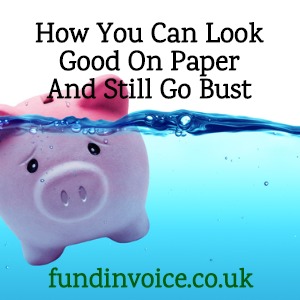- 06 May
How Can A Business Go Bust When It Looks Good On Paper

How can a business that looks good on paper, still go bust?
Financial Accounts Can Mislead You
In the UK, companies are required to file financial accounts with Companies House, each year. These show the trading performance for the previous year, in terms of a profit and loss account in some cases, and a balance sheet. The balance sheet shows the assets and liabilities that the company has at a given point in time.
See also: Analysing Financial Statements.
The reporting requirements are significantly less for smaller businesses, and a balance sheet may be all that is required, without the production of a profit and loss account.
However, when you look at a company's financial accounts, it can often show a position that is not consistent with its financial position at the current time. For example, a company could have a set of accounts showing profitability, and net worth, but it could still enter into some form of insolvency - as they run out of cash to pay their creditors.How Accounts May Not Match Reality
There can be a number of reasons for this.
Historic Information
Firstly, these types of financial statements are always historic. As soon as they are produced, they become historic. It is also possible to produce accounts that show a more favourable position than may be the reality. For example, a company could hold off making a number of cash disbursements, in order to show a large amount of cash in the bank account, in the financial statements. This could give an overly favourable view of their financial position, i.e. the day after the accounts were struck, they may have spent all that cash, or drawn it out as a dividend.
Asset Values
Secondly, the financial measures, that are recorded in financial statements, may not give a true representation of the financial position of the company.
For example, assets such as "intangible assets" can be added to the balance sheet, increasing the value of assets within the company. However, in some cases, these intangible assets may have very little value in a failure situation. For example, they could represent intellectual property or goodwill that may not realise any value if the company went bust.
There are also other assets that can be shown on a balance sheet but may be of little value. For example, in some cases, stock. If the company holds a large amount of stock, it may still require further processing to convert it into cash-generative sales. If the company were to fail and be unable to convert the stock, it could be of little value. However, it is possible to raise stock finance loans against it in some cases.Debtor Problems
Lastly, a company can appear very profitable, but it can still suffer a cash flow problem. For example, if a company is selling products, at a significant profit, they still need to be paid by the customer to realise the cash from that sale. A balance sheet can show outstanding debtors that have not been paid for significant periods of time, these may not be collectable debts.
Similarly, a company may be trading with a very narrow debtor base, which means that they are highly exposed, should any one of their customers fail to pay. The debts may be recorded in the balance sheet as assets, but may not be paid in the event of the debtor failing.Paper Performance Is No Guarantee
So looking at the financial statements of a business can give you an indication of its financial position. However, a company can still go bust, whilst things look good on paper. A good performance, on paper, is no guarantee that a business is sound. If you are concerned about your customers failing, you might want to consider bad debt protection.
- Home
- Business Financing
- Invoice Finance
- Invoice Discounting
- Factoring
- Debt Factoring
- Recourse Factoring
- Fund Selected Invoices
- Business Loans
- Construction Sector Funding
- Protect Against Bad Debts
- Exports Collection And Funding
- Import Funding
- Body Shop Funding
- Spot Factoring
- Retail Sector Funding
- Fund Invoices Confidentially
- Help Running Your Payroll
- CHOCs Customer Handles Own Collections
- Collect Invoices Confidentially And Funding
- Outsourcing Your Credit Control
- Asset Finance And Mortgages
- Case Studies
- About Us
- Testimonials
- Find Out More
- News
- Free Magazine
- Blog






